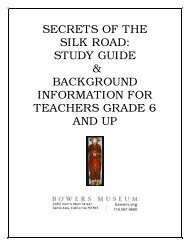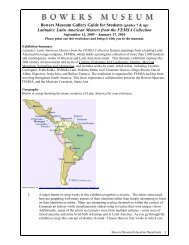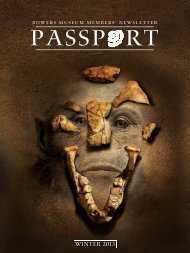A Resource Guide for Students and Teachers - Bowers Museum
A Resource Guide for Students and Teachers - Bowers Museum
A Resource Guide for Students and Teachers - Bowers Museum
You also want an ePaper? Increase the reach of your titles
YUMPU automatically turns print PDFs into web optimized ePapers that Google loves.
4. Comparing Ancient China,<br />
Modern China <strong>and</strong> Life as a<br />
Chinese American<br />
The students can read <strong>and</strong><br />
compare three books about life in<br />
ancient China, life in China today,<br />
<strong>and</strong> life as a Chinese American. This<br />
can be a class or individual activity.<br />
<strong>Students</strong> may use this activity to<br />
practice their reading aloud skills.<br />
As they read, ask the students to<br />
look <strong>for</strong> comparisons such as:<br />
1. What conclusions did the author<br />
reach about life <strong>for</strong> each time <strong>and</strong><br />
place?<br />
2. How are the lives of the characters<br />
in the stories alike or different?<br />
3. How are the lives of the characters<br />
in the stories alike or different<br />
from your own?<br />
4. What questions would you like to<br />
ask a character?<br />
5. What do you think a character<br />
would find strange about your<br />
life?<br />
6. Create a postcard a character<br />
might send you. What would be<br />
on the front of the card? What<br />
would the message be? Create<br />
a postcard you might send the<br />
character.<br />
7. Create a chart comparing the<br />
lives of a character from ancient<br />
China, a character from modern<br />
China, a Chinese American, <strong>and</strong><br />
yourself.<br />
24 TERRA COTTA WARRIORS<br />
Book <strong>and</strong> Character Responsibilities Family life Education Leisure Time Comments<br />
5. Observation Skills<br />
The TCW exhibit is a great place<br />
<strong>for</strong> students to practice their skill of<br />
observation. After their visit, students<br />
may write about what they observed. It<br />
is helpful to gather words while at the<br />
exhibition that they can use in their<br />
writings.<br />
Be<strong>for</strong>e coming to the exhibit, they<br />
will make a class list of things to<br />
look <strong>for</strong> such as qualities, properties,<br />
values, <strong>and</strong> descriptive words. To<br />
prepare, place the students in small<br />
groups. Give each group two objects<br />
that are similar such as two different<br />
dolls, different objects, or different<br />
pictures. Tell the class that they are<br />
to see which group can find the<br />
most features or descriptive words to<br />
compare about the two objects. They<br />
must work quietly so that other groups<br />
do not steal their ideas.<br />
After about five minutes, find<br />
which group has the most items to<br />
compare by asking one group to read<br />
its list, <strong>and</strong> the other groups mark<br />
off anything they name that is on<br />
their list. Then the next group tells<br />
the class the items on their list that<br />
were not already named by the first<br />
group. There will be class discussion<br />
generated about what items are<br />
the same or too similar to rename.<br />
Continue this through all the groups.<br />
Determine which group had<br />
the most items to compare. If one<br />
group has many more properties to<br />
compare, discuss how they created<br />
their list. If many properties to<br />
compare are left out by all the groups,<br />
prompt the class to add more by<br />
saying such things as: How do they<br />
feel? Are they pretty? How valuable are<br />
they? What are they used <strong>for</strong>? If time<br />
allows, blindfold one student <strong>and</strong> see<br />
if he/she comes up with any other<br />
ideas by touching the objects. As they<br />
are sharing their lists, create a class<br />
list on the board or overhead projector.<br />
Remember to look <strong>for</strong> color,<br />
shape, texture, size, patterns, to use<br />
all of their senses, <strong>and</strong> to use words<br />
describing emotions.<br />
The day of the trip to see the<br />
exhibt, remind the students of these<br />
things to observe, so that they see<br />
more details. Remind them to use all<br />
of their senses.<br />
6. Writing Activity<br />
During your tour of the exhibition,<br />
chose one aspect of the exhibit that<br />
you enjoyed the most. After your visit<br />
to the museum, write a persuasive<br />
letter to a friend to convince him/her<br />
to come see Terra Cotta Warriors:<br />
Guardians of China’s First Emperor.<br />
Remember to use your observation<br />
techniques to generate descriptive<br />
language in order to make your letter<br />
more convincing.





